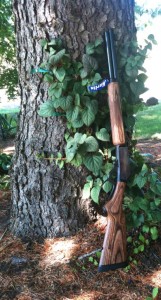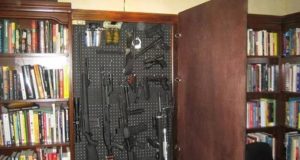This weapon is perhaps more ingrained in the Western United State’s history than any other rifle, and it is seen as the quintessential frontier gun. Its action is still impressive, and its usage is an excellent model of versatility and efficiency. However, it’s more than its rich history that gets it the nod for one of the ten best hunting rifles.
The Rifle: Marlin Lever-Action Big Bore
The Caliber: .45-70 Govt.
The Animal: Brown Bear, Wild Hog
The Rifle: Marlin 1895 GBL
 The Marlin 1895 GBL is a fast and proven rifle in a caliber fitting for a close proximity wooded area hunt that might include bears. It’s every bit as much a defensive weapon as it is a hunting rifle in larger game areas, and typically it does incredibly well where there is dense and heavy foliage or forest. This particular rifle is a blued version with a laminated wood stock, an 18.5-inch barrel, and a 6-shot tube magazine. It has an enlarged finger lever, side ejection, and pretty substantial sights. It has an overall length of 37 inches and a weight of about 7 pounds without ammunition. It’s short, fast to action, and is chambered in a round that is lethal at between 100 and 250 yards on all but the biggest game.
The Marlin 1895 GBL is a fast and proven rifle in a caliber fitting for a close proximity wooded area hunt that might include bears. It’s every bit as much a defensive weapon as it is a hunting rifle in larger game areas, and typically it does incredibly well where there is dense and heavy foliage or forest. This particular rifle is a blued version with a laminated wood stock, an 18.5-inch barrel, and a 6-shot tube magazine. It has an enlarged finger lever, side ejection, and pretty substantial sights. It has an overall length of 37 inches and a weight of about 7 pounds without ammunition. It’s short, fast to action, and is chambered in a round that is lethal at between 100 and 250 yards on all but the biggest game.
There are faster guns and certainly more accurate ones, but a lever-action seems to have some sort of unspoken bond with the man holding it in the field. It seems to move at just the right speed, have just the right feel and swing, and always have enough in reserve to keep you out of trouble. It’s no AR-15, and it’s certainly not as accurate as a high-end bolt gun, but it has a certain something about it that makes it capable and comforting to carry on a hunt, even if it isn’t your primary gun.
This model has a beautiful laminated stock, which keeps it weatherproof while still looking pretty good and allows for some added total durability. (The gun is available in a more weatherproof metal finish via the 1895 SBL.) A classic feel, look, and performance keeps you feeling like you are still part of the hunt, plus this rifle is as adept as any for using iron sights and killing larger game at less than 150 yards. The recoil pad comes standard, and the larger loop lever is an aid in colder environments where gloved hands are usually actuating it. It has a finished look few mainstream rifles have, and it certainly provides a straight-out-of-the box gun that is capable of just about anything.
The Caliber: .45-70 Govt.
It seems to be overkill for smaller and medium sized game, but there is certainly more versatility than the cartridge is usually given credit for. The relatively low velocity tends to be a bit more forgiving on game-meat animals than its faster-moving, smaller-diameter counterparts. While it perhaps isn’t reasonable to take a 105-pound doe with it, it can make sense for 150-pound hogs or 200 to 400-pound larger game animals like elk, moose and caribou.
The key to this cartridge is being familiar with it. Admittedly, with the recent rise in ammunition costs, this gun is more expensive to shoot than the .308 Winchester. You could arguably get the same result kill-wise with that cartridge, but the immediate benefit of the sheer size and usability of this cartridge provides a decent reason to consider it for dangerous and heavily wooded hunting country.
Again, this gun and cartridge isn’t for everyone, and it is certainly not cheap (although neither are those magnums), but it has a good place in its niche area and probably won’t be unseated any time soon. The cartridge has been hampered by its slow-rolling performance in the face of faster projectiles with smaller bullet diameters, but nearly seventy-five years after “experts” called it an obsolete cartridge, this round has made a full revival, and its comeback is nothing short of spectacular. There are so many loads available that a careful hunter could conceivably use this one gun and cartridge as his (or her) sole rifle and feel relatively comfortable with it. You won’t have to change upper receivers (no offense to the AR rifles) and spend for add-ons (other than perhaps a scope and a sling), but you could still conceivably use it to take animals from larger deer to cape buffalo—even an elephant if you knew what you were doing.
Interestingly, while many will tout the benefits of capacity, yet still hunt with a bolt gun holding three to four rounds, this weapon and cartridge combine for a seven-round magazine. (And really, when was the last time you used all ten, twenty, or thirty-plus rounds in your AR magazine while hunting? When, for that matter, were you comfortable carrying a .308 with four or five rounds in it in bear country without a massive sidearm to make up the difference?) Enter the .45-70; problem solved.
Most of the factory loads stay around 1600-1800 FPS for the 300-350 grain rounds, and while it’s possible to buy factory loads pushing 2400 FPS, it’s essentially a matter of how you want to use the round in the field.
A standard load from factory might have to be zeroed at around six additional inches above for 200 yards than it will be for 100 yards; such is the bullet drop common with such a heavy, large-diameter bullet. But most shooters will recognize performance almost identical in the terminal ballistics category at 300 grains and 1700 FPS at 100-200 yards to a “normal deer cartridge.” The .45-70 tends to be pretty flexible in its terminal ballistics performance, and the round is versatile across the range of game it can take down.
It doesn’t shoot flat, and it isn’t cheap; it kicks like a mule, and it can exceed weights of 500 grains in factory loads, but somehow, this ammunition makes a case for itself on pretty much any medium-to-large game it comes in contact with. There is something to be said in the defense of expensive, heavy, and bulky cartridges when they don’t require much money to add such versatility. Sure, you pay a bit more for the ammunition, but don’t you save in going without the unnecessary add-ons and the lack of additional rifles needed to take out a wider range of animals?
The Animals
Brown Bear
What does it take to bag a brown bear? You could say we already wrote an article about brown bears with the .375 H and H article, as we talked about the grizzly, North America’s version of the brown bear. Many of the best pieces of information about the “brown bear” can be seen there, so in fairness let’s talk a little about the wild hog to give some new information on an animal that absolutely makes sense for this cartridge and gun.
North American Wild Hog
An average weight of between about 100 pounds and 200 pounds puts these animals in the medium category, but these animals tend to be much more aggressive than their average weight suggests. A relatively small kill zone of seven to eleven inches (on a smaller framed hog) from behind the ears to just behind the front legs and above them makes this animal relatively difficult to kill. A larger caliber with slower-moving heavy bullets makes good sense for this animal, and the .45-70 fits in well.
Game trail cameras can be helpful in finding these wild hogs, which tend to be relatively elusive.
The tracking and natural signs of hogs include analysis of the rooting and troughs as well as looking for wallowing holes (big mud pits with pig-shaped indentations in them). Baiting is also an increasingly popular tactic in pig hunting. Using diesel fuel soaked corn keeps other animals away from the bait and keeps the hogs interested, though it’s best to avoid long term exposure to these baits when you plan on eating the meat harvested.
Every state in the U.S. and vast portions of Mexico and Canada are home to the wild hog, and many states or regions have loose laws with regards to hunting them; in some states it is always open season with no limit.
Hog meat isn’t bad by any means, even above certain weight or size, though it isn’t as good as you will find with other game meats and especially with commercial hogs, due to the toughness and leaner meat composition. Generally speaking for hogs under 225 pounds, if cooked correctly, the meat will be a tasty, a slightly gamier pork taste with many of the same qualities of commercial pork, with less fat content.
This rifle and cartridge combination takes some getting used to, and the “honeymoon phase” can be a wallet-straining and tedious exercise. Once you know how to use the weapon however, it’s a foregone conclusion that anything bigger than a small buck can be taken in North America with it, depending on how well you tailor the cartridge to the game. And for that matter, many animals in Eurasia and Africa don’t really stand a chance against it, provided that you do your homework and know how to hit the target. What other gun besides the AR-15 chassis can give this kind of versatility in a single rifle?
©2012 Off the Grid News
 Off The Grid News Better Ideas For Off The Grid Living
Off The Grid News Better Ideas For Off The Grid Living



